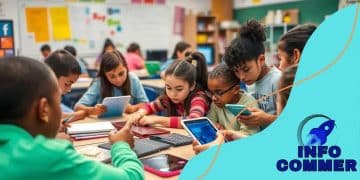The impact of virtual classrooms on student collaboration

The impact of virtual classrooms on student collaboration includes enhanced communication, access to diverse peers, and the necessity of adopting effective tools and best practices to overcome challenges like technical issues and lack of face-to-face interaction.
Have you noticed how the impact of virtual classrooms on student collaboration is changing the landscape of education? As we dive deeper into online learning, it’s fascinating to see how technology fosters teamwork and interaction among students.
Defining virtual classrooms
Defining virtual classrooms is essential to understanding their role in modern education. These digital environments allow students to learn and collaborate remotely, transforming traditional classroom settings. Virtual classrooms utilize technology to create interactive learning experiences, connecting students and teachers from diverse locations.
In a virtual classroom, various tools enhance the learning experience. For instance, real-time video conferencing platforms enable live discussions, while discussion boards allow students to engage asynchronously. These features contribute significantly to the overall effectiveness of virtual education.
Key Features of Virtual Classrooms
Here are some features that define virtual classrooms:
- Interactive learning tools, such as quizzes and polls.
- Access to multimedia resources, including videos and articles.
- Collaboration tools that facilitate group work and discussions.
- Flexibility in scheduling, allowing for diverse learning paces.
As technology advances, the definition of virtual classrooms expands. They adapt to include more innovative features that enhance student engagement and collaboration. For example, gamification elements motivate students to participate actively. This evolution makes virtual classrooms increasingly appealing to learners seeking interactive and engaging educational experiences.
Furthermore, the global reach of virtual classrooms is remarkable. Students from various backgrounds can unite, greatly enriching the learning atmosphere. This diversity not only enhances collaboration but also broadens perspectives, fostering a deeper understanding of different cultures.
Ultimately, defining virtual classrooms goes beyond just identifying their components. It involves recognizing their potential to revolutionize how education is delivered, making learning accessible and meaningful for all.
Enhancing communication among students
Enhancing communication among students is a key benefit of virtual classrooms. These platforms provide unique opportunities for learners to interact with each other in real-time, breaking down barriers that traditional classrooms often face. The ability to share ideas instantly is crucial for collaborative learning.
Virtual classrooms often use various tools to promote communication. For example, chat functions allow students to discuss topics while lectures are happening. This real-time interaction can help clarify doubts and engage students more thoroughly.
Benefits of Enhanced Communication
Here are some key benefits of enhanced communication in virtual classrooms:
- Increased engagement: Students feel more connected and involved.
- Improved collaboration: Working together on projects becomes easier.
- Instant feedback: Students can ask questions and receive answers quickly.
- Networking opportunities: Students can build relationships with peers from different locations.
Furthermore, effective communication tools foster a sense of community among students. When learners can communicate freely, they are more likely to share their thoughts and experiences. This openness leads to a richer exchange of ideas, enhancing the overall learning process.
Additionally, virtual classrooms allow for diverse communication styles. Students can utilize text, video, or audio to express themselves. This variety caters to different learning preferences, ensuring that every student finds a way to participate effectively.
Incorporating collaborative activities, such as group discussions or projects, can also elevate communication levels. When students work together toward common goals, their communication skills improve as they learn to articulate their thoughts and listen to others.
Tools that facilitate collaboration

Tools that facilitate collaboration are essential in virtual classrooms. They enhance the learning experience by allowing students to work together efficiently, regardless of their physical location. These digital tools make communication seamless and promote teamwork among classmates.
One of the most popular tools used for collaboration is video conferencing software. These platforms enable students to participate in live discussions and share their thoughts in real time. As a result, students can engage with each other and their instructors effectively.
Essential Collaboration Tools
Here are some tools that significantly enhance collaboration among students:
- Google Workspace: Offers tools like Google Docs and Sheets for real-time editing and sharing.
- Microsoft Teams: Combines chat, video, and file sharing in one platform to foster communication.
- Trello: A project management tool that helps students organize tasks and collaborate on projects.
- Slack: A messaging app designed for teams to communicate and share files easily.
Moreover, discussion boards are another valuable component. These platforms allow students to post questions or share insights, encouraging asynchronous interaction. By posting comments or replying to peers, students can participate at their own pace, leading to deeper discussions.
Additionally, cloud storage services like Dropbox or Google Drive allow students to store and work on files together. Shared folders make it easy for everyone to access important documents and contribute to group assignments. This accessibility enhances collaborative efforts and keeps everyone on the same page.
Using these tools not only improves collaboration but also prepares students for future work environments. In today’s job market, teamwork and the ability to use digital tools are highly valued. Thus, learning to collaborate using these platforms offers students valuable skills for their careers.
Challenges in virtual teamwork
Challenges in virtual teamwork often arise due to the unique dynamics of online interactions. When collaborating remotely, students face obstacles that can hinder effective communication and group cohesion. Understanding these challenges is vital to improving teamwork and enhancing learning outcomes.
One common challenge is the lack of face-to-face interaction. When students work in virtual classrooms, they miss out on non-verbal cues, such as body language and expressions. This lack of visual feedback can lead to misunderstandings and make it harder to build trust among team members.
Common Obstacles to Effective Virtual Teamwork
Here are some challenges students may encounter in virtual teamwork:
- Time zone differences: When collaborating with peers in different regions, coordinating meetings can be difficult.
- Technical issues: Connectivity problems or software glitches can disrupt communication and workflow.
- Distractions at home: Students may struggle to focus due to external factors in their environment.
- Limited team interaction: Fewer opportunities for social bonding can affect group dynamics.
Moreover, students may feel isolated or unmotivated in a virtual setting. The absence of direct interactions can affect engagement levels and make it challenging to form connections with classmates. This sense of isolation can lead to lower participation and hinder collaborative efforts.
To address these challenges, teams can implement strategies that foster communication and connection. For instance, scheduling regular check-ins and using video calls can help build rapport among team members. Setting clear expectations and roles within the group also enhances accountability and collaboration.
Additionally, utilizing collaborative tools effectively might mitigate some of these challenges. For instance, integrating project management apps can streamline communication and keep tasks organized. Encouraging peer feedback and discussions about group dynamics can also create a supportive environment that fosters teamwork.
Best practices for effective virtual collaboration
Best practices for effective virtual collaboration play a vital role in ensuring that teams work well together in online environments. Implementing these strategies can enhance communication, build trust, and create productive team dynamics.
One essential practice is to establish clear goals and expectations. When everyone understands their role and the project’s objectives, it sets a solid foundation for collaboration. Teams should discuss their goals at the start to align their efforts effectively.
Key Strategies for Successful Virtual Collaboration
Here are some best practices to consider:
- Regular check-ins: Schedule frequent meetings to discuss progress and address any challenges the team may face.
- Utilize the right tools: Leverage collaboration tools like Slack, Trello, or Google Workspace to improve communication and organization.
- Encourage open communication: Create an environment where team members feel comfortable sharing ideas and feedback.
- Be adaptable: Embrace flexibility in work styles, as everyone may have different preferences and schedules.
Moreover, fostering team bonding is crucial in virtual settings. Organizing virtual team-building activities can strengthen relationships among team members. Simple activities, like virtual coffee breaks or fun online games, can help break the ice and build camaraderie.
Additionally, active listening is a vital aspect of effective collaboration. Team members should focus on understanding each other’s perspectives without interrupting. This practice can lead to better decision-making and a more inclusive environment for discussions.
Ultimately, recognizing and celebrating team achievements is essential for morale. Acknowledging the contributions of team members fosters a positive atmosphere and increases motivation. Simple gestures, like shout-outs during meetings or sending appreciation messages, can significantly impact team spirit.
In conclusion, the impact of virtual classrooms on student collaboration is significant and multifaceted. These online environments offer numerous benefits, such as increased communication, flexible learning, and the opportunity to connect with diverse peers. However, challenges like technical issues and the absence of face-to-face interactions can arise. By adopting best practices and utilizing effective tools, students can enhance their collaborative experiences. Embracing these strategies not only improves teamwork but also prepares students for future success in a digital world.
FAQ – Frequently Asked Questions about Virtual Classrooms and Collaboration
How can virtual classrooms enhance student collaboration?
Virtual classrooms allow students to communicate and work together in real-time, fostering teamwork and enabling diverse interactions.
What are some common challenges faced in virtual teamwork?
Students often struggle with technical issues, lack of face-to-face interaction, and time zone differences, which can hinder effective collaboration.
What tools are recommended for effective collaboration in virtual classrooms?
Popular tools include Google Workspace for document sharing, Trello for project management, and Zoom for video conferencing.
What best practices can improve collaboration among students?
Establishing clear goals, maintaining regular check-ins, and encouraging open communication are vital for successful collaboration.





